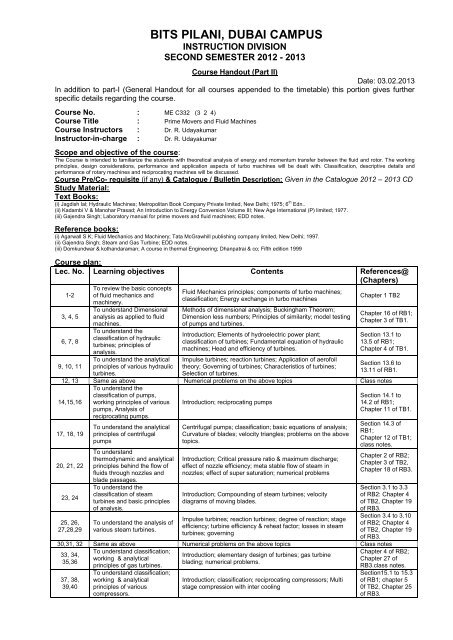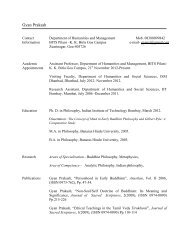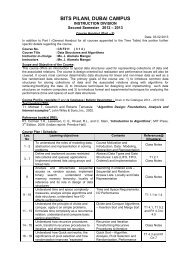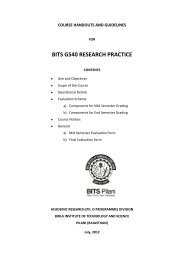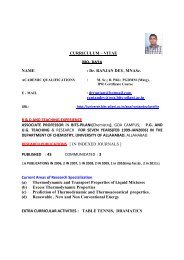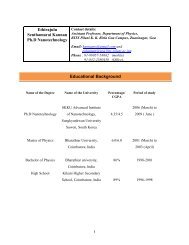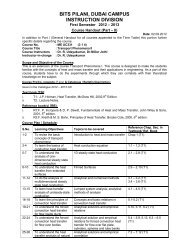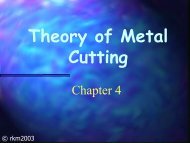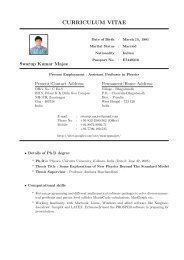H - Student Welfare Division - BITS Pilani
H - Student Welfare Division - BITS Pilani
H - Student Welfare Division - BITS Pilani
- No tags were found...
You also want an ePaper? Increase the reach of your titles
YUMPU automatically turns print PDFs into web optimized ePapers that Google loves.
<strong>BITS</strong> PILANI, DUBAI CAMPUSINSTRUCTION DIVISIONSECOND SEMESTER 2012 - 2013Course Handout (Part II)Date: 03.02.2013In addition to part-I (General Handout for all courses appended to the timetable) this portion gives furtherspecific details regarding the course.Course No. : ME C332 (3 2 4)Course Title : Prime Movers and Fluid MachinesCourse Instructors : Dr. R. UdayakumarInstructor-in-charge : Dr. R. UdayakumarScope and objective of the course:The Course is intended to familiarize the students with theoretical analysis of energy and momentum transfer between the fluid and rotor. The workingprinciples, design considerations, performance and application aspects of turbo machines will be dealt with. Classification, descriptive details andperformance of rotary machines and reciprocating machines will be discussed.Course Pre/Co- requisite (if any) & Catalogue / Bulletin Description: Given in the Catalogue 2012 – 2013 CDStudy Material:Text Books:(i) Jagdish lal; Hydraulic Machines; Metropolitan Book Company Private limited, New Delhi; 1975; 6 th Edn..(ii) Kadambi V & Manohar Prasad; An Introduction to Energy Conversion Volume III; New Age International (P) limited; 1977.(iii) Gajendra Singh; Laboratory manual for prime movers and fluid machines; EDD notes.Reference books:(i) Agarwall S K; Fluid Mechanics and Machinery; Tata McGrawhill publishing company limited, New Delhi; 1997.(ii) Gajendra Singh; Steam and Gas Turbine; EDD notes.(iii) Domkundwar & kothandaraman; A course in thermal Engineering; Dhanpatrai & co; Fifth edition 1999Course plan:Lec. No. Learning objectives Contents References@(Chapters)1-23, 4, 56, 7, 89, 10, 11To review the basic conceptsof fluid mechanics andmachinery.To understand Dimensionalanalysis as applied to fluidmachines.To understand theclassification of hydraulicturbines; principles ofanalysis.To understand the analyticalprinciples of various hydraulicturbines.Fluid Mechanics principles; components of turbo machines;classification; Energy exchange in turbo machinesMethods of dimensional analysis; Buckingham Theorem;Dimension less numbers; Principles of similarity; model testingof pumps and turbines.Introduction; Elements of hydroelectric power plant;classification of turbines; Fundamental equation of hydraulicmachines; Head and efficiency of turbines.Impulse turbines; reaction turbines; Application of aerofoiltheory; Governing of turbines; Characteristics of turbines;Selection of turbines.Chapter 1 TB2Chapter 16 of RB1;Chapter 3 of TB1.Section 13.1 to13.5 of RB1;Chapter 4 of TB1.Section 13.6 to13.11 of RB1.12, 13 Same as above Numerical problems on the above topics Class notes14,15,16To understand theclassification of pumps,working principles of variouspumps, Analysis ofreciprocating pumps.Introduction; reciprocating pumps17, 18, 1920, 21, 2223, 2425, 26,27,28,29To understand the analyticalprinciples of centrifugalpumpsTo understandthermodynamic and analyticalprinciples behind the flow offluids through nozzles andblade passages.To understand theclassification of steamturbines and basic principlesof analysis.To understand the analysis ofvarious steam turbines.Centrifugal pumps; classification; basic equations of analysis;Curvature of blades; velocity triangles; problems on the abovetopics.Introduction; Critical pressure ratio & maximum discharge;effect of nozzle efficiency; meta stable flow of steam innozzles; effect of super saturation; numerical problemsIntroduction; Compounding of steam turbines; velocitydiagrams of moving blades.Impulse turbines; reaction turbines; degree of reaction; stageefficiency; turbine efficiency & reheat factor; losses in steamturbines; governingSection 14.1 to14.2 of RB1;Chapter 11 of TB1.Section 14.3 ofRB1;Chapter 12 of TB1;class notes.Chapter 2 of RB2;Chapter 3 of TB2,Chapter 18 of RB3.Section 3.1 to 3.3of RB2: Chapter 4of TB2, Chapter 19of RB3.Section 3.4 to 3.10of RB2; Chapter 4of TB2, Chapter 19of RB3.30,31, 32 Same as above Numerical problems on the above topics Class notesTo understand classification;33, 34,Introduction; elementary design of turbines; gas turbineworking & analytical35,36blading; numerical problems.principles of gas turbines.37, 38,39,40To understand classification;working & analyticalprinciples of variouscompressors.Introduction; classification; reciprocating compressors; Multistage compression with inter coolingChapter 4 of RB2;Chapter 27 ofRB3.class notes.Section15.1 to 15.3of RB1; chapter 50f TB2, Chapter 25of RB3.
41, 42, 43To understand the analyticalprinciples of centrifugalcompressors and variousother compressorsCentrifugal compressors; slip in centrifugal compressors;stagnation values in centrifugal compressors; axial flowcompressors; cascade flow; velocity triangles; work done anddegree of reaction.Section 15.4 to15.6 of RB1;chapter 5 of TB2,Chapter 26 of RB3.44,45 Same as above Numerical problems on the above topics Class notes* The lectures may be slightly diverge from aforesaid plan based on students ‘background & interest in the topic, whichmay perhaps include special lectures and discussions that would be planned and schedule notified accordingly.Laboratory Experiments: Following is the list of experiments that the students have to do in the labpractical classes.Cycle 1 Cycle 2SN Name SN Name1 Study of Internal Combustion Engines. 1 Heat balance test on a multi-cylinder petrol engine2 Valve Timing and port timing Diagrams. 2 Heat balance test on a twin cylinder diesel engine.3 Performance test on a Twin-cylinder Diesel Engine. 3Study of Steam Boilers and Steam Turbines.4 Performance test on Air Compressor. 4 Characteristics of Francis Turbine.5Performance test and MORSE test on a multi cylinderCharacteristics of Kaplan turbine.5Petrol Engine.6 Characteristics of Pelton Turbine. 6 Characteristics of Centrifugal Pump.Evaluation Scheme:EC No Components Duration Weightage% Date & Time Venue1 Test-I 50 minutes 15% 18.03.13 M 62 Quiz-120-25minutes05 % To be announced3 Test - 2 50 minutes 15 % 13.05.13 M 64 Quiz-220-25minutes05 % To be announced2 hrs class5 Lab report & vivafor each ( 8+7) % Continuousweek6 Lab compre 2 hours 10% To be announced7 Comprehensive Exam 3 hours. 35 % 10.06.13 M (FN)* Only prescribed text book(s) and hand written notes are permitted.Mid-sem Grading:Mid-sem grading will be displayed after two evaluation components or earlier when- ever about 40 % ofevaluation components are completed.Note: A student will be likely to get “NC”, if he / she Doesn’t appear / appear for the sake of appearing for the evaluation components / scoring zero inpre-compre total. Scoring zero in the lab component / Abstaining from lab classes throughout.Makeup and Attendance policies:Make-ups are not given as a routine. It is solely dependent upon the genuineness of the circumstancesunder which a student fails to appear in a scheduled evaluation component. In such circumstances, priorpermission should be obtained from the Instructor-in-Charge (I/C).The decision of the I/C in the abovematter will be final.Attendance: Every student is expected to be responsible for regularity of his/her attendance in classrooms and laboratories, to appear in scheduled tests and examinations and fulfill all other tasks assignedto him/her in every course. A student should have a minimum of 50% of attendance in a course to beeligible to appear for the Comprehensive Examination in that course. For the students under the purview ofAcademic Counseling Board (ACB), the Board shall prescribe the minimum attendance requirement on acase-to-case basis. Attendance in the course will be a deciding factor in judging the seriousness of astudent which may be directly / indirectly related to grading.General timings for consultation:Each instructor will specify his / her chamber consultation hours duringwhich the student can contact him / her in his / her chamber for consultation. (For details see part II)General instructions:<strong>Student</strong>s should come prepared for classes and carry the text book(s) or material(s) as prescribed by theCourse Faculty to the class.Notices:All notices concerning the course will be displayed on the respective Notice Boards.To be announced laterInstructor-in-ChargeDr.R.UdayakumarInstructor’s Contact details: Dr.R.Udayakumar (Course Coordinator) – Academic Block, Chamber No:274 Contact Tel. No: 04 4200700 Extn. 287, Email: udaya@bits-dubai.ac.ae


